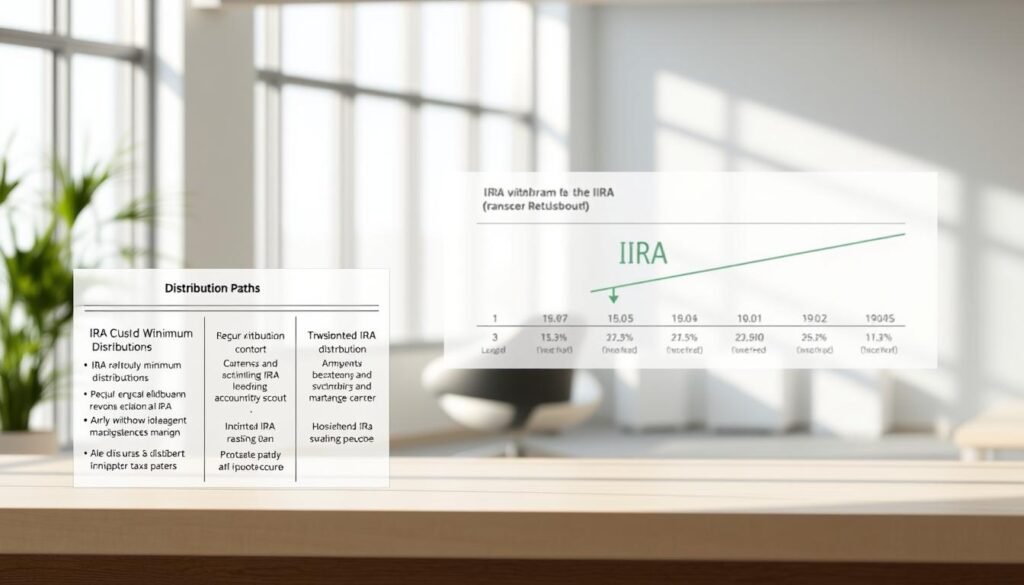When you think about family, you imagine comfort, small traditions, and the hope that what you build lasts. This guide begins with that feeling. It aims to turn concern into clear action so your retirement account supports loved ones when you are gone.
Today’s rules for inherited IRAs changed for deaths in 2020 and later. Beneficiary type and the original owner’s age at death shape timelines, taxes, and options. I will walk you through the key choices that reduce friction and shield value for heirs.
We’ll cover timing traps like year-of-death RMDs and the nine-month disclaimer window. You’ll learn when a lump-sum is taxable and why self-directed IRAs may let you hold real estate or other property — but also why collectibles and plan lookthrough rules can trigger an immediate tax bill.
Think of this as practical planning: align investment options, custodian choices, and transfer design with your heirs’ needs so your estate moves smoothly and with minimal tax friction.
Key Takeaways
- New inherited-IRA rules depend on beneficiary type and owner age at death.
- Year-of-death RMDs must be satisfied to avoid steep penalties.
- Disclaimers give heirs nine months to refuse an inheritance when useful.
- Self-directed accounts allow property but watch prohibited collectibles and lookthrough risks.
- Choose custodian and transfer methods to match heirs’ liquidity and income needs.
Understand your goal: preserving a tangible store of wealth for heirs
Start by deciding whether your goal is income for heirs or a clear, simple transfer of value.
The IRS defines certain collectibles as prohibited in an ira under IRC 408(m)(2). That list includes art, antiques, some metals, stamps, and coins unless they meet the 408(m)(3) exceptions. Buying prohibited items can trigger a deemed distribution and extra tax costs.
In everyday terms, heirs often think “tangible” means something they can see or use — a rental property that pays rent or a physical asset that feels real.
Weigh control versus simplicity. Direct real estate gives hands-on control and cash flow. REITs or funds are easier to manage but offer less direct influence for the owner and beneficiaries.
- Match your timeline to required distribution rules so taxes and cash needs align.
- Document a written strategy that names custodians, transfer steps, and short-term actions for heirs.
- Plan liquidity so heirs can cover income tax, expenses, and fees without forced sales.
Map your beneficiary strategy under today’s SECURE Act rules
Start by mapping who will inherit your IRA and which distribution rules will apply to each individual.
This step clarifies beneficiary types so you can align your retirement account designations with intended outcomes. For deaths in 2020 or later, the SECURE Act splits beneficiaries into designated and eligible designated beneficiaries (EDBs).
Designated vs. eligible designated beneficiaries
EDBs include a spouse, a direct descendant under 21, someone less than 10 years younger, and disabled or chronically ill individuals. These beneficiaries have more flexible distribution options than standard designated beneficiaries under the new rules.
Special treatments and timing
A spouse may roll over funds to their own IRA or delay required withdrawals until the decedent would have reached RMD age. Most non-EDB beneficiaries must empty the account by the end of the 10th year. If the owner died after reaching RMD age, annual withdrawals during those years may also be required.

Trusts and estate considerations
Trust outcomes depend on trust language. A properly drafted see-through trust can preserve tax deferral and protect heirs, but complex trusts need counsel. Estates named as beneficiaries often follow the 5-year rule if the owner died before RMD age, or payout over remaining life expectancy if after.
| Beneficiary Type | Main Rule | Key Consideration |
|---|---|---|
| Spouse | Rollover or inherited IRA; delay RMDs | Choice affects transfer and income timing |
| Eligible Designated | Life-expectancy or extended options | Includes minor child (until 21), disabled |
| Designated (non-EDB) | 10-year full distribution | Annual RMDs if owner died after RMD age |
| Estate / Non-designated | 5-year or life-expectancy rules | Depends on owner’s age at death |
Choose the right distribution path to maximize what heirs keep
A smart transfer plan balances liquidity needs, tax timing, and long‑term preservation for beneficiaries.

Rollover for spouses versus inherited accounts
Spouses may roll funds into their own IRA or leave them as an inherited account. A rollover preserves tax deferral and keeps retirement account rules simple.
Note: any year‑of‑death RMD the owner left outstanding must be withdrawn by December 31. Missing it risks heavy penalties.
10‑year rule, life‑expectancy payouts, and estates
Most designated beneficiaries face the 10‑year rule: the account must be emptied by year 10. If the owner died after RMD age, annual withdrawals may be required during those years.
Estates and non‑designated beneficiaries often use the 5‑year rule when death occurs before RMD age. If death was after RMD age, payouts can follow the decedent’s remaining life expectancy.
Coordinating year‑of‑death RMDs and tax sequencing
Calculate the year‑of‑death RMD first, then plan distributions that manage taxable income. Filling lower tax brackets over several years or bunching charitable gifts can reduce total tax paid.
- Compare a spouse rollover versus an inherited ira for transfer flexibility and future distributions.
- Build a pacing plan to avoid a year‑10 surprise under the 10‑year rule.
- Document a simple playbook for heirs: custodian contact, required forms, and timing steps.
How can I pass down a tangible store of wealth through my IRA?
Holding real estate or notes inside an IRA gives heirs an asset that feels real, while keeping tax deferral intact.
Using self-directed IRAs to access real estate and other alternative assets
A self-directed ira lets investors own rental homes, mortgage notes, tax liens, or private partnerships inside the account. All income and expenses must flow through the account, and the owner may not use the property personally.
Custodians that support self-directed iras handle titling and recordkeeping. They ensure the account — not you personally — is listed as buyer and owner.
Structuring for heirs: liquidity, titling, and custodian capabilities
Plan liquidity so beneficiaries have cash for taxes, insurance, and upkeep. Keep some income-producing investments or reserve cash in the account to avoid forced sales at transfer.
Confirm your custodian can service heirs and complete a smooth transfer or distribution. Name primary and contingent beneficiaries that match estate documents.
Practical rules to avoid compliance problems
- Never allow personal use or “sweat equity.”
- Avoid prohibited collectibles under IRC rules; check coin and bullion exceptions.
- Do not transact with disqualified persons — this risks a deemed distribution and penalties.
Finally, build a beneficiary binder with property deeds, leases, insurance, custodian contact, and a simple calendar of obligations. This short playbook helps heirs move quickly and preserve estate value.
Self-directed IRA real estate: compliant ways to create durable, “real world” value
Using an IRA for direct property investments demands strict compliance but can preserve value for beneficiaries.
Permissible options include residential rentals, commercial spaces, improved or unimproved land, public or private REITs, mortgage notes, trust deeds, tax lien certificates, joint ventures, and limited partnerships. Each type can fit an heir-focused plan: rentals for steady income, REITs for liquidity, and notes for predictable cash flow.

Compliance guardrails
The custodian must hold title in the account name and all receipts and expenses must flow through the account. No personal use, no services or “sweat equity,” and no deals with disqualified persons. These rules prevent deemed distributions and steep tax penalties.
Direct property vs. REITs
Direct ownership gives heirs control and ongoing income but demands active management and liquidity. REITs provide diversification and easier transfer at death, with less administrative burden for the estate.
Funding and tax risks
Purchases may use all-cash from the account or non-recourse loans. Be aware: debt-financed income can trigger UDFI/UBIT that the account must pay. Keep cash reserves in the IRA for vacancies, repairs, insurance, and taxes to avoid forced sales.
- Example: an IRA buys a rental home with a non-recourse loan; rent flows into the account, and heirs inherit an income-producing asset.
- Create a written property-management plan for heirs: who to hire, how rent is collected into the account, and how to request distributions.
Avoid prohibited collectibles and lookthrough pitfalls
Before you add art, classic cars, or certain funds to an IRA, know the rules that can convert an investment into a taxable event.
What counts as a collectible: IRC 408(m)(2) bars IRAs from owning art, rugs, antiques, metals and gems (with limits), stamps, alcoholic beverages, and other tangible personal property designated by the IRS.
Limited exception: IRC 408(m)(3) allows specific coins and bullion that meet metallurgical standards, but only if they are held in trust and vetted by your custodian.
Plan-asset lookthrough rules
The DOL treats an account as owning underlying holdings when a self-directed IRA holds more than 25% of an investment entity, or 100% of an operating company (29 C.F.R. §2510.3-101).
This means indirect interests can turn into prohibited assets for your IRA. Get full written information from sponsors before you invest.
Real examples and practical cautions
“A fund that buys fine art or classic cars may be imputed to your account and trigger a deemed distribution equal to cost.”
- Example: a classic‑car fund looks attractive, but if underlying cars are prohibited, the IRA may face immediate tax and penalties.
- Example: partnerships holding collectibles can impute assets to the account—check ownership percentages and documents.
- Providing services or operating a business-like venture linked to the investment can create prohibited transactions and compound penalties.
| Risk Type | What Triggers It | Action for Owner / Custodian |
|---|---|---|
| Prohibited collectible | Direct purchase of art, rugs, antiques, alcoholic beverages | Confirm IRC classification and avoid purchase |
| Coin/bullion exception | Metallurgical standard coins held in trust | Use custodian-approved trust storage and documentation |
| Plan-asset lookthrough | IRA owns >25% of an entity or 100% of operating co. | Require sponsor disclosure of underlying assets and percentages |
Next step: ask sponsors and your custodian for complete asset lists and lookthrough analysis, and follow formal guidance to avoid prohibited transactions.
Tax timing, penalties, and practical planning for heirs
Timing decisions after an owner’s death affect how much heirs keep.
Traditional IRA distributions count as ordinary tax. Heirs should model expected income and income tax to decide whether to spread withdrawals over several years to manage brackets.
Roth five‑year rule and early withdrawal notes
Inherited Roth accounts generally avoid the 10% early withdrawal penalty for beneficiaries.
To get tax‑free treatment, the Roth must meet the five‑year rule. Verify the original account opening date before assuming distributions are tax-free.
Annual RMDs when the decedent was past RMD age
Under final regs, many designated beneficiaries must take annual RMDs during the 10‑year period if the owner died after RMD age.
Any year‑of‑death RMD not taken must be withdrawn by December 31 or the estate risks a heavy penalty.
UBIT and UDFI for leveraged or business-like real estate
Business income inside an IRA may trigger UBIT; debt‑financed property can create UDFI. The IRA pays these taxes and files the returns, not the beneficiary’s personal return.
| Issue | Effect on Heirs | Practical Move |
|---|---|---|
| Traditional distributions | Subject to ordinary tax | Plan withdrawals to manage brackets |
| Roth five‑year rule | Determines tax-free status | Confirm account opening date |
| Year‑of‑death RMD | Missed RMD = penalty | Complete withdrawal by Dec 31 |
| UBIT / UDFI | IRA-level tax on business or leveraged income | Set aside cash in account; consult tax pro |
Practical checklist: keep cash reserves in accounts for taxes, coordinate distributions with other estate income, and give custodians clear documentation to speed transfer and reporting.
Conclusion
End with a clear planning strategy that balances taxes, liquidity, and the investments your heirs will manage.
, Align your accounts and retirement accounts so each owner and beneficiary understands timing and transfer steps. Consolidate investment options toward what heirs can maintain. Keep some cash in accounts to cover taxes and upkeep to protect estate value and return.
Choose custodians and professional services that support self-directed property and handle beneficiary requests quickly. Sync beneficiary designations with your trust and will and document the transfer playbook so heirs avoid delays.
Practical action: confirm titles and records, pre-plan liquidity for taxes and upkeep, educate the beneficiary, and review this strategy each year so your account and estate deliver the results you intend.
FAQ
What does “tangible” mean under IRS rules versus practical, concrete value?
“Tangible” isn’t a formal IRS term for IRAs. The IRS focuses on asset type, prohibited transactions, and custody. Practically, tangible means assets heirs can see and use — rental property, land, physical bullion held by an approved custodian, or mortgage notes. To keep value concrete, choose assets with clear title, reliable cash flow, and custodial structures that meet IRS rules.
How do I balance control, taxes, and timing in an estate plan for an IRA?
Start by naming beneficiaries and updating them after major life events. Weigh keeping investment control now against tax outcomes later: traditional IRAs pass income tax liability to heirs, while Roth IRAs offer tax-free distributions if rules are met. Consider trusts, spousal rollovers, or designating a spouse to inherit to extend tax-deferral. Work with an estate attorney and CPA to align timing, tax exposure, and your desire for legacy control.
What’s the difference between designated and eligible designated beneficiaries under the SECURE Act?
A designated beneficiary is any person named to inherit an IRA. An eligible designated beneficiary (EDB) — such as a surviving spouse, minor child of the decedent, disabled or chronically ill person, or someone not more than 10 years younger — can use life-expectancy payout options. Most non-EDB individuals must use the 10-year rule, accelerating distributions and taxes.
How are spouses, minor children, and disabled heirs treated differently?
Spouses can roll the IRA into their own account or remain an inherited IRA owner. Minor children can stretch distributions until they reach majority using life-expectancy rules; once they reach adulthood the 10-year rule typically applies. Disabled or chronically ill beneficiaries often qualify as EDBs and may use longer payout schedules. Each status affects timing, taxes, and planning choices.
When should I name a trust as IRA beneficiary?
Use a trust when you need creditor protection, control over timing of payouts, or to manage distributions for beneficiaries who lack financial maturity. A “see-through” (conduit or accumulation) trust can preserve stretch benefits only if drafted to meet IRS look-through rules. Always consult an estate attorney familiar with IRA and SECURE Act nuances to avoid unintended tax acceleration.
What distribution paths maximize what heirs keep?
Spousal rollover typically preserves tax-deferral, letting a spouse treat the account as their own. For non-spouse beneficiaries, life-expectancy payouts (if allowed) spread taxes, while the 10-year rule requires full distribution within ten years, versus immediate lump sums. Roth IRAs minimize income tax for heirs if the five-year rule has been met. Coordinate beneficiary choices with tax planning to reduce bite from income tax brackets.
How does a spouse rolling over an inherited IRA differ from an inherited IRA for other beneficiaries?
A spouse can roll an inherited IRA into their own IRA, treating it as a personal account and delaying RMDs until their required age. Non-spouse beneficiaries cannot roll into their own IRA and must follow inherited IRA rules, often triggering the 10-year rule. That difference has large tax and timing implications.
What is the 10-year rule, and when do life-expectancy payouts still apply?
The 10-year rule requires most beneficiaries to empty the IRA within ten years of the owner’s death. Life-expectancy payouts still apply to eligible designated beneficiaries, allowing annual distributions based on the beneficiary’s life expectancy. Estates and certain trusts face special rules, such as the five-year rule if no designated beneficiary exists.
How should year-of-death RMDs be handled to avoid penalties?
The year-of-death RMD must be calculated and distributed according to the decedent’s required distribution status. If the decedent already reached RMD age, the RMD for that year is due and cannot be moved to heirs. Properly calculate and distribute that RMD promptly to avoid the 50% excise tax on missed amounts.
What is a self-directed IRA and how does it enable real estate or alternative assets?
A self-directed IRA is an account where the custodian allows investments beyond stocks and mutual funds, including real estate, private loans, and notes. It enables ownership of tangible assets inside tax-advantaged accounts. Custodial rules, prohibited transaction restrictions, and title requirements must be followed closely to maintain tax-favored status.
How do I structure real estate in an IRA for heirs — what about titling and custodian capabilities?
The IRA — not you — must hold title. Use an IRA custodian that supports real estate and understands required documents. Title typically reads in the custodian’s name for the benefit of the IRA. Plan for liquidity at death: rental income and sale proceeds flow through the IRA, but heirs inherit the IRA interest and distribution timing rules apply. Ensure your custodian can handle transfers to heirs or trust beneficiaries.
What real estate types are permissible inside a self-directed IRA?
Permissible options include rental residential or commercial property, raw land, certain mortgage notes, REITs, and partnership interests. Physical real estate must never be used personally by the account owner or disqualified persons. Work with custodians such as Equity Trust, Pensco (by BNY Mellon), or Entrusty that support these asset types and compliance.
What are the key prohibited transaction rules and who are disqualified persons?
Prohibited transactions include self-dealing, selling property between the IRA and disqualified persons, or otherwise benefiting personally from IRA assets. Disqualified persons include the IRA owner, spouse, ancestors and lineal descendants, their fiduciaries, and controlled entities. Violations can trigger immediate taxation and penalties, so avoid any personal use or indirect benefits.
Should I use direct property ownership or REITs for heirs’ cash flow versus simplicity?
Direct ownership can provide tangible value and rental income, but brings management, liability, and liquidity challenges for heirs. REITs and publicly traded real estate offer simpler transfer, liquidity, and professional management, but less direct control. Choose based on heirs’ capacity, desired legacy, and your tolerance for administrative complexity.
How do funding methods like non-recourse loans affect taxes and UDFI/UBIT exposure?
Using leverage with an IRA requires non-recourse loans. Income from leveraged property can trigger Unrelated Business Taxable Income (UBTI), resulting in UBIT to the IRA. UDFI (unrelated debt-financed income) specifically applies to leveraged real estate. These taxes reduce net returns and complicate reporting, so model effects before leveraging inside an IRA.
Are collectibles allowed in IRAs? What about coins and bullion?
Most collectibles (art, antiques, stamps, certain coins, and classic cars) are prohibited. However, certain coins and bullion that meet IRS specifications and are held by an approved custodian may be allowed. Trust-held arrangements sometimes permit gold or silver bullion, but strict custody and documentation rules apply to avoid penalties and deemed distributions.
What are plan asset “lookthrough” rules and why do they matter?
Lookthrough rules can treat underlying assets of an investment (like a partnership or LLC) as if the IRA directly owned them. That can create prohibited transaction risk or require disclosure of disqualified-party involvement. Proper structuring and legal review help prevent unintended imputation of assets to the IRA.
Why do art, classic cars, and similar assets trigger penalties inside IRAs?
These items are commonly classified as collectibles and are expressly disallowed. Holding them in an IRA can create a deemed distribution equal to their fair market value, triggering income tax and possible penalties. The IRS enforces these rules strictly to prevent personal enjoyment of tax-sheltered property.
How are distributions taxed for heirs, and how does Roth five-year rule affect free withdrawals?
Traditional IRA distributions to heirs are taxed as ordinary income when distributed. Roth IRA distributions are tax-free if the account has met the five-year holding period. If the five-year period hasn’t passed, earnings distributed may be taxable. Estate planning should account for these differences to minimize heirs’ tax bills.
What are annual RMD rules under final regulations when the decedent was past RMD age?
If the decedent had begun RMDs, beneficiaries may be required to continue either life-expectancy payouts (for EDBs) or follow the 10-year rule depending on beneficiary status and account type. The year-of-death RMD must be satisfied. Final regulations clarify calculation methods and deadlines, so consult a qualified advisor to comply and avoid excise taxes.
When does UBIT/UDFI apply to leveraged or business-like real estate activity inside IRAs?
UBIT applies when an IRA engages in an active trade or business or borrows via non-recourse financing that produces unrelated debt-financed income (UDFI). Income subject to UBIT reduces net returns and triggers tax filings for the IRA. Passive investments like REIT dividends typically avoid UBIT, but leveraged property often does not.
What practical steps should heirs take after inheriting an IRA with real estate or alternative assets?
Immediately notify the custodian, obtain copies of account documents, and review beneficiary and trust designations. Assess liquidity needs: selling property inside the IRA may require custodian approval and time. Consult an estate attorney and tax advisor before any distributions, sales, or transfers to avoid prohibited transactions and unexpected taxes.




